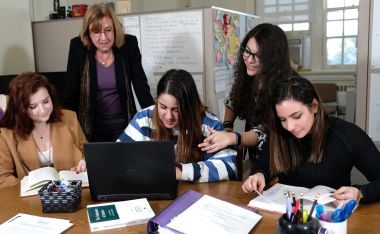Guaranteed Counsel
SCJ Team Studies Impact of Not Being Represented First Court Appearance
 |
|
Associate Professor Alissa Worden and Ph.D. student Reveka Shteynberg (standing) work with student interns (seated, left to right) Kaitlin Moloney, Emilia Sacco and Molly Strauss in the CAFA office at the School of Criminal Justice. (Photo by Patrick Dodson) |
ALBANY, N.Y. (Oct. 23, 2018) — The Sixth Amendment of the United States Constitution guarantees “assistance of counsel” to those facing prosecution, meaning that if a person charged with a crime cannot afford a lawyer, the court will assign one.
But what happens in rural areas where a lawyer might not be available in the middle of the night, or the midst of a winter blizzard? These are the kinds of situations that a research team from the School of Criminal Justice set out to investigate.
As part of the Counsel at First Appearance (CAFA) project, Associate Professor Alissa Pollitz Worden, alums Andrew L.B. Davies and Kirstin A. Morgan, and Ph.D. student Reveka V. Shteynberg have spent years examining the impact of providing counsel at arraignment. The team followed six counties in upstate New York that were awarded grants to initiate programs that ensure legal counsel at first appearance for those arrested.
The project began in 2012 when the state Office of Indigent Legal Services issued the grants. Seeing the possibility for an in-depth, multi-site study, Worden and Davies (that office's director of research) applied for a research grant from the National Institute of Justice, which awarded the team $380,000 in 2014.
“Until recently, outside urban city courts, few jurisdictions could ensure that people arrested and arraigned on misdemeanor or felony charges would have an attorney present to represent their interests, particularly after hours or on weekends, or in jurisdictions whose courts only hold sessions once or twice a week,” said Worden.
“The concern was that in the absence of legal advocacy, the judges would make decisions that err on the side of setting bail that most people can’t make, so the defendant would end up spending more time in jail, with collateral consequences for the defendant as well as the community.”
The project examines the practices being implemented in each county, seeing which worked and which fell short, and how other factors — such as county politics and geography — impacted the process.
“One of the things that was interesting was actually watching the politics in these communities," said Worden. "In one of them, there is a criminal justice counsel that meets monthly and that is a very collaborative county. They address policy issues like, ‘What’s best for the whole system?’
“In other counties, however, there was considerable resistance in other criminal justice agencies to these practices and to the state’s help to this reform. The politics surrounding the implementation became part of the whole story.”
She added, “In this state, so much of policy is driven by the conditions in New York City that we must explain to people that getting a lawyer to a courthouse at maybe 2 o'clock in the morning in a blizzard could be a two-hour trip. These are isolated towns with maybe only a few lawyers available.”
Over the course of four years, during which 15 interns joined the project, the team made multiple trips to each of the six counties — driving around 14,000 miles, Shteynberg said — investigating the effects that CAFA had on case decisions and outcomes. And in May, their preliminary findings were published in the journal Criminal Justice Policy Review. The results suggest that defendants who have attorneys at arraignment may be more likely to be released on recognizance, less likely to have high bail set and therefore less likely to be jailed pending disposition.
In August the study was the topic of an article in the London School of Economics daily American Politics and Policy blog.
“This has been a very eye-opening experience,” Shteynberg said. “It’s given me a great amount of field research experience working on a large, multi-year grant-funded project which many individuals in my position have not had the opportunity to do.”
She added, “The biggest piece of it was really just doing this kind of policy-relevant research on a large scale — there is so much data, so much information we’re going to be able to publish on for probably decades.
"I’m very fortunate for this opportunity. It’s become more than just a research assistantship. What this has turned into is a collaboration on a huge project that is going to be able to inform a whole host of policy-relevant issues, including issues surrounding the national movements to reform bail and to provide adequate defense counsel to indigent defendants.”
![]() For more news, subscribe to UAlbany's RSS headline feeds
For more news, subscribe to UAlbany's RSS headline feeds
A comprehensive public research university, the University at Albany-SUNY offers more than 120 undergraduate majors and minors and 125 master's, doctoral and graduate certificate programs. UAlbany is a leader among all New York State colleges and universities in such diverse fields as atmospheric and environmental sciences, business, education, public health,health sciences, criminal justice, emergency preparedness, engineering and applied sciences, informatics, public administration, social welfare and sociology, taught by an extensive roster of faculty experts. It also offers expanded academic and research opportunities for students through an affiliation with Albany Law School. With a curriculum enhanced by 600 study-abroad opportunities, UAlbany launches great careers.


